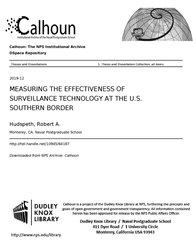File:MEASURING THE EFFECTIVENESS OF SURVEILLANCE TECHNOLOGY AT THE U.S. SOUTHERN BORDER (IA measuringtheeffe1094564187).pdf

Original file (1,275 × 1,650 pixels, file size: 1.06 MB, MIME type: application/pdf, 90 pages)
Captions
Captions
Summary[edit]
| MEASURING THE EFFECTIVENESS OF SURVEILLANCE TECHNOLOGY AT THE U.S. SOUTHERN BORDER
( |
||
|---|---|---|
| Author |
Hudspeth, Robert A. |
|
| Title |
MEASURING THE EFFECTIVENESS OF SURVEILLANCE TECHNOLOGY AT THE U.S. SOUTHERN BORDER |
|
| Publisher |
Monterey, CA; Naval Postgraduate School |
|
| Description |
The United States’ investment in southern border security has consistently been a topic of discussion regarding technological improvements and measurements of effectiveness. There have been multiple failed programs designed to combine infrastructure, personnel, and technology ranging from the America’s Shield Initiative (ASI) to the Secure Borders Initiative Network (SBInet). These efforts have resulted in billions of dollars of wasted funding. The latest initiative, named the Southwest Border Technology Plan, claims to use lessons learned from previous failures and focuses on integrating systems tailored to individual sectors of the border. A related issue is the use of apprehension rates and other passive metrics as the measures of effectiveness for the security of the southern border, continuing the historical inconsistency of inaccurate reporting methods. The Department of Homeland Security (DHS) has recognized the problem of inadequate measurement and is developing new methods with the assistance of improved data captured with biometric systems; however, the issue of inaccurate reporting remains. An alternate and more active option to consider for measuring security effectiveness is red teaming. This thesis explores the following questions: what technologies are currently utilized for border security and how can their effectiveness be measured? And, can red teaming be used to improve on existing measures of effectiveness? Subjects: technology; border; security; effectiveness; red teaming |
|
| Language | English | |
| Publication date | December 2019 | |
| Current location |
IA Collections: navalpostgraduateschoollibrary; fedlink |
|
| Accession number |
measuringtheeffe1094564187 |
|
| Source | ||
| Permission (Reusing this file) |
This publication is a work of the U.S. Government as defined in Title 17, United States Code, Section 101. Copyright protection is not available for this work in the United States. | |
Licensing[edit]
| Public domainPublic domainfalsefalse |
This work is in the public domain in the United States because it is a work prepared by an officer or employee of the United States Government as part of that person’s official duties under the terms of Title 17, Chapter 1, Section 105 of the US Code.
Note: This only applies to original works of the Federal Government and not to the work of any individual U.S. state, territory, commonwealth, county, municipality, or any other subdivision. This template also does not apply to postage stamp designs published by the United States Postal Service since 1978. (See § 313.6(C)(1) of Compendium of U.S. Copyright Office Practices). It also does not apply to certain US coins; see The US Mint Terms of Use.
|
 | |
| This file has been identified as being free of known restrictions under copyright law, including all related and neighboring rights. | ||
https://creativecommons.org/publicdomain/mark/1.0/PDMCreative Commons Public Domain Mark 1.0falsefalse
File history
Click on a date/time to view the file as it appeared at that time.
| Date/Time | Thumbnail | Dimensions | User | Comment | |
|---|---|---|---|---|---|
| current | 20:04, 22 July 2020 |  | 1,275 × 1,650, 90 pages (1.06 MB) | Fæ (talk | contribs) | FEDLINK - United States Federal Collection measuringtheeffe1094564187 (User talk:Fæ/IA books#Fork8) (batch 1993-2020 #21405) |
You cannot overwrite this file.
File usage on Commons
The following page uses this file:
Metadata
This file contains additional information such as Exif metadata which may have been added by the digital camera, scanner, or software program used to create or digitize it. If the file has been modified from its original state, some details such as the timestamp may not fully reflect those of the original file. The timestamp is only as accurate as the clock in the camera, and it may be completely wrong.
| Short title | MEASURING THE EFFECTIVENESS OF SURVEILLANCE TECHNOLOGY AT THE U.S. SOUTHERN BORDER |
|---|---|
| Image title | |
| Author | Hudspeth, Robert A. |
| Software used | Hudspeth, Robert A. |
| Conversion program | Adobe PDF Library 15.0 |
| Encrypted | no |
| Page size | 612 x 792 pts (letter) |
| Version of PDF format | 1.4 |

